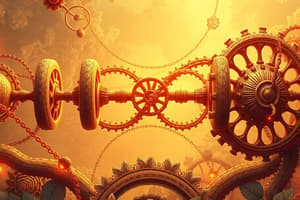Podcast
Questions and Answers
In ATP synthesis, what happens when the γ subunit rotates by 120° in a counterclockwise direction?
In ATP synthesis, what happens when the γ subunit rotates by 120° in a counterclockwise direction?
- Forms a proton gradient
- Halts ATP release
- Converts the T-form subunit into the O-form (correct)
- Allows ATP to be synthesized
What is the main role of the proton gradient in ATP synthesis?
What is the main role of the proton gradient in ATP synthesis?
- Interconverting ADP and Pi
- Forming ATP directly
- Releasing ATP from the synthase (correct)
- Allowing ATP to be synthesized
Which system introduces electrons from cytoplasmic NADH into the electron transport chain?
Which system introduces electrons from cytoplasmic NADH into the electron transport chain?
- Krebs cycle
- Glycolysis pathway
- Malate–aspartate shuttle (correct)
- Oxidative phosphorylation
How is electron motion across the membrane related to ATP synthesis?
How is electron motion across the membrane related to ATP synthesis?
What is the ATP yield ratio for NADH in terms of ATP produced?
What is the ATP yield ratio for NADH in terms of ATP produced?
How does ADP enter the mitochondrial matrix?
How does ADP enter the mitochondrial matrix?
What is the main function of Iron–sulfur proteins (FeSPs) in the electron transport chain?
What is the main function of Iron–sulfur proteins (FeSPs) in the electron transport chain?
Which molecule is essential as a reactant for ATP synthesis?
Which molecule is essential as a reactant for ATP synthesis?
What is the role of ATPase in ATP synthesis?
What is the role of ATPase in ATP synthesis?
Which molecular assembly carries out the oxidative phosphorylation of ADP or the synthesis of ATP?
Which molecular assembly carries out the oxidative phosphorylation of ADP or the synthesis of ATP?
According to chemiosmotic coupling, what couples electron transport and ATP synthesis in the mitochondria?
According to chemiosmotic coupling, what couples electron transport and ATP synthesis in the mitochondria?
Which mechanism leads to the release of tightly bound ATP from ATP synthase?
Which mechanism leads to the release of tightly bound ATP from ATP synthase?
What is the main function of the Electron-transport chain (ETC) and Oxidative Phosphorylation?
What is the main function of the Electron-transport chain (ETC) and Oxidative Phosphorylation?
What is the role of the Proton Gradient in oxidative phosphorylation?
What is the role of the Proton Gradient in oxidative phosphorylation?
Which structure in the cell is responsible for hosting the Electron-transport chain and Oxidative Phosphorylation processes?
Which structure in the cell is responsible for hosting the Electron-transport chain and Oxidative Phosphorylation processes?
What drives electron transfer in the Reduction Potentials of ETC?
What drives electron transfer in the Reduction Potentials of ETC?
Which process depends on the coupling between oxidation and phosphorylation?
Which process depends on the coupling between oxidation and phosphorylation?
What is a common inhibitor that can block Electron-transport chain (ETC) and ATP synthase?
What is a common inhibitor that can block Electron-transport chain (ETC) and ATP synthase?




